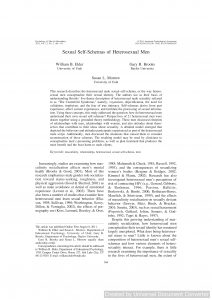Socialization & Relationship Outcomes
Sexual Self-Schemas of Heterosexual Men
 Full Article Name: Sexual Self-Schemas of Heterosexual Men
Full Article Name: Sexual Self-Schemas of Heterosexual Men
Open Access: No
Abstract
This research describes the heterosexual male sexual self-schema, or the way heterosexual men conceptualize their sexual identity. The authors use as their basis of understanding Brooks’ five-theme description of heterosexual male sexuality referred to as “The Centerfold Syndrome,” namely, voyeurism, objectification, the need for validation, trophyism, and the fear of true intimacy. Self-schemas derive from past experience, affect current experiences, and facilitate the processing of sexual information. Using these concepts, this study addressed the question: how do heterosexual men understand their own sexual self-schemas? Perspectives of 21 heterosexual men were drawn together using a grounded theory methodology. These men discussed elements of relationships with men, relationships with women, and also attitudes about themselves that contribute to their ideas about sexuality. A detailed model emerged that depicted the behaviors and attitudes participants experienced as part of the heterosexual male script. Additionally, men discussed the situations that caused them to consider reconstruction of these schemas. The resulting model may be used by clinicians to conceptualize men’s presenting problems, as well as plan treatment that produces the most benefit and the least harm to male clients.
Citation
Elder, W. B., Brooks, G. R., & Morrow, S. L. (2012). Sexual self-schemas of heterosexual men. Psychology of Men & Masculinity, 13(2), 166–179. https://doi.org/10.1037/a0024835

